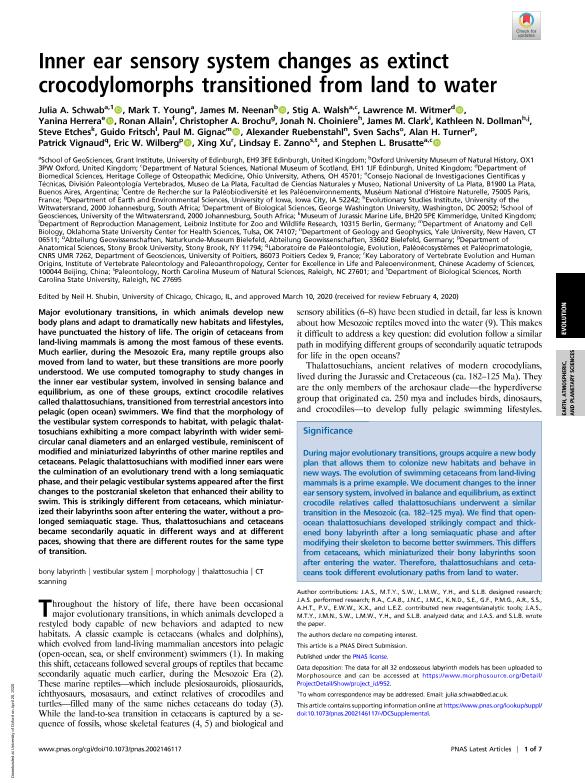Mostrar el registro sencillo del ítem
dc.contributor.author
Schwab, Julia A.
dc.contributor.author
Young, Mark T.
dc.contributor.author
Neenan, James M.
dc.contributor.author
Walsh, Stig A.
dc.contributor.author
Witmer, Lawrence

dc.contributor.author
Herrera, Laura Yanina

dc.contributor.author
Allain, Ronan

dc.contributor.author
Brochu, Christopher A.
dc.contributor.author
Choiniere, Jonah N.
dc.contributor.author
Clark, James M.
dc.contributor.author
Dollman, Kathleen N.
dc.contributor.author
Etches, Steve
dc.contributor.author
Fritsch, Guido
dc.contributor.author
Gignac, Paul M.
dc.contributor.author
Ruebenstahl, Alexander
dc.contributor.author
Sachs, Sven
dc.contributor.author
Turner, Alan H.
dc.contributor.author
Vignaud, Patrick
dc.contributor.author
Wilberg, Eric W.
dc.contributor.author
Xu, Xing

dc.contributor.author
Zanno, Lindsay E.
dc.contributor.author
Brusatte, Stephen L.
dc.date.available
2021-07-19T13:24:23Z
dc.date.issued
2020-05
dc.identifier.citation
Schwab, Julia A.; Young, Mark T.; Neenan, James M.; Walsh, Stig A.; Witmer, Lawrence; et al.; Inner ear sensory system changes as extinct crocodylomorphs transitioned from land to water; National Academy of Sciences; Proceedings of the National Academy of Sciences of The United States of America; 117; 19; 5-2020; 10422-10428
dc.identifier.issn
0027-8424
dc.identifier.uri
http://hdl.handle.net/11336/136402
dc.description.abstract
Major evolutionary transitions, in which animals develop new body plans and adapt to dramatically new habitats and lifestyles, have punctuated the history of life. The origin of cetaceans from land-living mammals is among the most famous of these events. Much earlier, during the Mesozoic Era, many reptile groups also moved from land to water, but these transitions are more poorly understood. We use computed tomography to study changes in the inner ear vestibular system, involved in sensing balance and equilibrium, as one of these groups, extinct crocodile relatives called thalattosuchians, transitioned from terrestrial ancestors into pelagic (open ocean) swimmers. We find that the morphology of the vestibular system corresponds to habitat, with pelagic thalattosuchians exhibiting a more compact labyrinth with wider semicircular canal diameters and an enlarged vestibule, reminiscent of modified and miniaturized labyrinths of other marine reptiles and cetaceans. Pelagic thalattosuchians with modified inner ears were the culmination of an evolutionary trend with a long semiaquatic phase, and their pelagic vestibular systems appeared after the first changes to the postcranial skeleton that enhanced their ability to swim. This is strikingly different from cetaceans, which miniaturized their labyrinths soon after entering the water, without a prolonged semiaquatic stage. Thus, thalattosuchians and cetaceans became secondarily aquatic in different ways and at different paces, showing that there are different routes for the same type of transition.
dc.format
application/pdf
dc.language.iso
eng
dc.publisher
National Academy of Sciences

dc.rights
info:eu-repo/semantics/openAccess
dc.rights.uri
https://creativecommons.org/licenses/by-nc-sa/2.5/ar/
dc.subject
BONY LABYRINTH
dc.subject
CT SCANNING
dc.subject
MORPHOLOGY
dc.subject
THALATTOSUCHIA
dc.subject
VESTIBULAR SYSTEM
dc.subject.classification
Paleontología

dc.subject.classification
Ciencias de la Tierra y relacionadas con el Medio Ambiente

dc.subject.classification
CIENCIAS NATURALES Y EXACTAS

dc.title
Inner ear sensory system changes as extinct crocodylomorphs transitioned from land to water
dc.type
info:eu-repo/semantics/article
dc.type
info:ar-repo/semantics/artículo
dc.type
info:eu-repo/semantics/publishedVersion
dc.date.updated
2021-07-15T12:26:42Z
dc.journal.volume
117
dc.journal.number
19
dc.journal.pagination
10422-10428
dc.journal.pais
Estados Unidos

dc.journal.ciudad
Washington DC
dc.description.fil
Fil: Schwab, Julia A.. University of Edinburgh; Reino Unido
dc.description.fil
Fil: Young, Mark T.. University of Edinburgh; Reino Unido
dc.description.fil
Fil: Neenan, James M.. University of Oxford; Reino Unido
dc.description.fil
Fil: Walsh, Stig A.. University of Edinburgh; Reino Unido
dc.description.fil
Fil: Witmer, Lawrence. Ohio University; Estados Unidos
dc.description.fil
Fil: Herrera, Laura Yanina. Universidad Nacional de La Plata. Facultad de Ciencias Naturales y Museo. División Paleontología Vertebrados; Argentina. Consejo Nacional de Investigaciones Científicas y Técnicas. Centro Científico Tecnológico Conicet - La Plata; Argentina
dc.description.fil
Fil: Allain, Ronan. Muséum National d'Histoire Naturelle; Francia
dc.description.fil
Fil: Brochu, Christopher A.. University of Iowa; Estados Unidos
dc.description.fil
Fil: Choiniere, Jonah N.. University of the Witwatersrand; Sudáfrica
dc.description.fil
Fil: Clark, James M.. The George Washington University. Columbian College Of Arts And Sciences. Department Of Biological Sciences.; Estados Unidos
dc.description.fil
Fil: Dollman, Kathleen N.. University of the Witwatersrand; Sudáfrica
dc.description.fil
Fil: Etches, Steve. Museum of Jurassic Marine Life; Reino Unido
dc.description.fil
Fil: Fritsch, Guido. Leibniz Institute For Zoo And Wildlife Research.; Alemania
dc.description.fil
Fil: Gignac, Paul M.. Oklahoma State University; Estados Unidos
dc.description.fil
Fil: Ruebenstahl, Alexander. University of Yale; Estados Unidos
dc.description.fil
Fil: Sachs, Sven. Natural History Museum, Bielefeld ; Alemania
dc.description.fil
Fil: Turner, Alan H.. Stony Brook University ; State University Of New York;
dc.description.fil
Fil: Vignaud, Patrick. Stony Brook University ; State University Of New York;
dc.description.fil
Fil: Wilberg, Eric W.. Stony Brook University ; State University Of New York;
dc.description.fil
Fil: Xu, Xing. Chinese Academy of Sciences; República de China
dc.description.fil
Fil: Zanno, Lindsay E.. North Carolina State University; Estados Unidos
dc.description.fil
Fil: Brusatte, Stephen L.. University of Edinburgh; Reino Unido
dc.journal.title
Proceedings of the National Academy of Sciences of The United States of America

dc.relation.alternativeid
info:eu-repo/semantics/altIdentifier/url/http://www.pnas.org/lookup/doi/10.1073/pnas.2002146117
dc.relation.alternativeid
info:eu-repo/semantics/altIdentifier/doi/http://dx.doi.org/10.1073/pnas.2002146117
Archivos asociados
